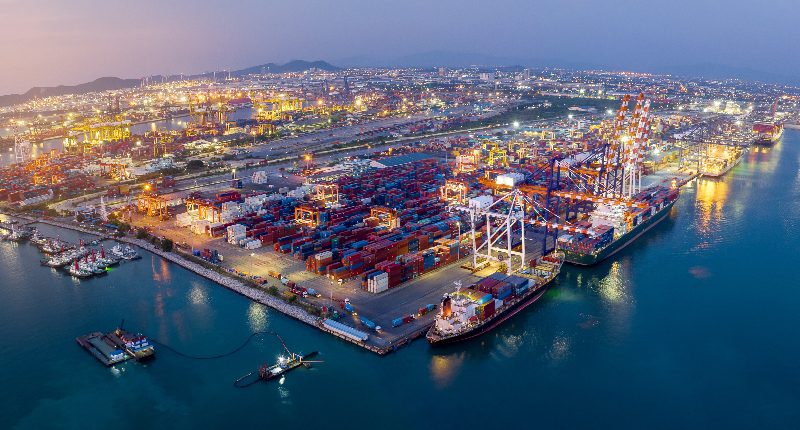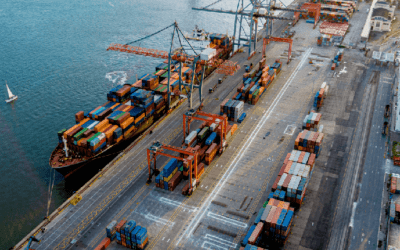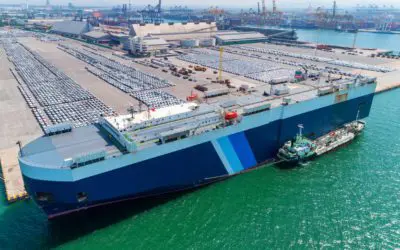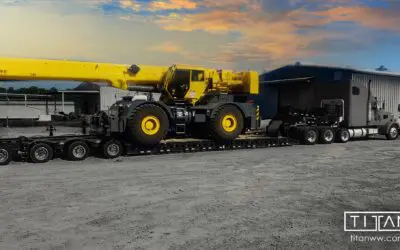What is Ocean Freight Forwarding, and How Does It Work?
Ocean freight, also called sea freight or ocean cargo, is international freight shipping by sea. Although it’s the most popular option for sending goods overseas, ocean freight shipping is not the only method for international shipping since air freight is also an alternative. Still, estimates indicate that approximately 90% of goods are transported worldwide via ocean freight services, making it the leader in overseas shipping services.
Ocean freight forwarding ensures smooth global trade by managing sea shipment logistics, from booking and handling paperwork to delivery and tracking, providing a safe, efficient service.
Types of Ocean Freight Services
Container Shipping
One of the most common methods of shipping goods is container shipping, technically called containerization. With this shipping option, goods are shipped in containers of standard sizes of 20 to 40 feet. Their popularity stems from their ease of handling and relative safety since containers are moveable without disturbing the cargo. Container shipping works best with dry or already packaged goods.
Two container shipping services are available: less than container load (LCL) and full container load (FCL).
FCL shipments refer to shipping goods using one or more containers your company uses exclusively. Because only your goods are in the container, you can rest assured that your freight will remain undisturbed until you open the container. FCL is an excellent option when your shipment fills (or at least nearly fills) the container.
On the other hand, with LCL shipments, ocean freight does not fill the container, so you will not have the container to yourself. Instead, you will share it with others, making your shipment more vulnerable to damage or mishandling during the voyage. However, one advantage of LCL is that it’s less expensive since you can split the cost with whomever you share the container.
Breakbulk
Breakbulk ocean shipping is a cargo shipping method for goods that cannot fit in standard-size shipping containers or cargo bins. Instead, they are shipped in bags, boxes, crates, drums, barrels, and other handling equipment. They can also be lifted, pushed, or rolled onto the ship.
Common breakbulk goods include steel girders, oversized goods, structural steel, large rolls, manufacturing machinery, construction equipment, and vehicles. Even though containers remain the most utilized shipping method, breakbulk is ideal for shipping large items with door-to-door services. And because large cargo need not be dismantled to ship, there is a reduction in time and money with breakbulk.
Liquid Bulk
Bulk liquid transport is more complex than breakbulk, and shipping companies must follow specific guidelines and protocols. Correct labeling and proper shipping documentation are essential.
Bulk liquids may be stored at the final destination port before being loaded and taken to the recipient. Flexitanks are non-reusable tanks storing up to 24,000 liters of bulk liquid and are ideal for ocean shipments. Put the liquids into the tank and load them into a 20′ standard shipping container.
Reusable stainless steel tanks are the conventional transportation method for liquid foodstuffs, specialty chemicals, and petrochemicals. They can be temperature-controlled for sensitive liquids and are easily cleaned and sanitized.
Temperature-Controlled Ocean Freight
Using state-of-the-art technologies, most shippers offer refrigerated cargo services worldwide. The reefer is one more customized solution for ocean transportation, and it’s designed to ship ocean freight cargo, including life sciences, pharmaceuticals, chemicals, perishable goods, and more.
How are Ocean Shipping Rates Calculated?
Ocean freight has relatively affordable freight costs. Typically, ocean cargo rates are calculated by twenty-foot equivalent units or TEUs. A TEU is the standard size of a shipping container (20 ft. long x 8 feet wide x 8 feet tall). It is 20 feet long, 8 feet wide, and 8 feet tall. Incoterms and land-sea-land transportation also factor into the cost of ocean freight rates.
The cost per weight of goods and the space they take up, with ocean freight costs around 50 cents per kilogram (kg). Other charges factoring into the freight rate include:
- Cargo insurance
- Customs security surcharge and tariffs
- Container freight station (this applies to LCL consolidation only)
- Pickup and delivery at ports and warehouses
- Routing charges
- Customs Brokerage
- Fuel surcharge
Ocean freight charges are constantly changing depending on several variables that include:
- Fuel costs: Fuel prices can be volatile, and when prices rise, rates will also.
- Exchange rates: Even small fluctuations in exchange rates can mean a loss for a shipping company, particularly when considering the length of a single trip.
- Supply and demand: Festive holidays can make people work less, affecting the shipping industry.
- Shipment size: Larger-sized shipments mean much more work and higher labor costs.
- Type of vessel required: Containerized shipping is quick, easy, and practical, making it relatively inexpensive. Conversely, tankers for liquid cargo or bulk carriers for unpackaged dry goods might cost more.
How Do Ocean Freight and Air Freight Compare?
Determining the better ocean transportation mode for your freight requires careful analysis. An occasional review of your supply chain won’t be enough to keep it efficient and cost-effective.
No matter which method you choose, working with a logistics and freight expert who offers comprehensive global logistics solutions, market updates, and technology services can help ensure that the process you want is available when you need it.
Consider the following when evaluating whether ocean or air freight shipping offers the better option to meet your current transportation needs.
Ocean Freight
- Ocean freight offers more capacity and value
- Ocean freight has longer transit times than air, and customs clearance and port holdups can cause additional delays.
- Express LCL is increasingly available on more routes, often guaranteeing a delivery date, and is faster than regular ocean freight.
- Ocean freight leaves a smaller carbon footprint and fewer emissions than air freight.
- There are fewer restrictions for shipping by sea.
Air Freight
- Air freight is best used when the cost of shipping is less than 15-20% of the value of the goods.
- Air freight is faster, safer, and more reliable than ocean freight, but it’s also much more expensive. For instance, an ocean shipment costing around $200 could cost about $1,000 by air.
- Airlines have stricter regulations for shipping hazardous materials.
Count on Logistics Solutions from the Freight Experts at Titan Worldwide
At Titan Worldwide, we collaborate with our international heavy equipment shipping division and project logistics team to arrange the ideal transportation program to fit your needs. After many years of building relationships with air and shipping lines, we now have the ultimate network of numerous national trucking companies.
International oversized equipment shipping requires attention to detail, careful planning, and flawless execution. The shipping cost will depend on the size of the cargo, machinery, or heavy equipment being transported.
But what is considered oversize freight? Simply any cargo unable to fit inside a 40-ft. cargo shipping container. Some machinery and equipment don’t have the dimensions to fit the standard specifications of an international heavy equipment shipping container service. In that case, we have alternatives:
- Flat Rack Shipping Method: A large container without walls and roof used for shipping boats, trucks, heavy machinery, and RVs overseas.
- Lift-On Lift-Off (LoLo): As the term suggests, shipping with LoLo is used when the ship has no storage in the hull, so a crane loads the items, machines, or equipment directly onto the deck.
- Roll-On Roll-Off (RoRo): Using the RoRo method for shipping oversize freight internationally is a simple and cost-effective option for large vehicles like trucks, motor homes, and RVs. These vehicles “roll” onto the ship below deck and are safe from the elements.
Talk to a Titan Team Member for Personalized Logistics Solutions
Globalization and talent shortages in the supply chain industry are increasing pressure on organizations worldwide. Make sure you plan for how your goods will be transported to the port of origin for export, and also how your goods will be picked up at the port and taken to their inland destination. Titan Worldwide is a trusted partner for shippers who need reliable transportation services. We specialize in some of the most challenging types of cargo, such as oversized loads that require heavy haul trucking and transport. Contact us today for assistance with your supply chain!




